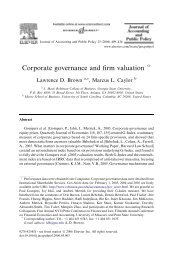Income Dynamics, Economic Rents and the Financialization of the ...
Income Dynamics, Economic Rents and the Financialization of the ...
Income Dynamics, Economic Rents and the Financialization of the ...
You also want an ePaper? Increase the reach of your titles
YUMPU automatically turns print PDFs into web optimized ePapers that Google loves.
modities <strong>and</strong> Investment industry. It is <strong>the</strong>se individuals that Rauh <strong>and</strong> Kaplan (2007) show are<br />
increasingly in <strong>the</strong> top one-tenth <strong>of</strong> one percent <strong>of</strong> earners nationally.<br />
--Figure 7 about here--<br />
Using similar data, Philippon <strong>and</strong> Reshef (2009) suggest that up-grades in <strong>the</strong> education<br />
level <strong>of</strong> employees <strong>and</strong> <strong>the</strong> skill mix <strong>of</strong> jobs may account for at least some <strong>of</strong> <strong>the</strong> rising incomes<br />
in this sector. This is an argument that <strong>the</strong> sector became more skilled, ra<strong>the</strong>r than <strong>the</strong>re was an<br />
increase in income rents to <strong>the</strong> average employee in <strong>the</strong> sector. 18 Appendix B reports shifts in<br />
sector <strong>and</strong> industry employee education <strong>and</strong> occupational structure. The proportion college edu-<br />
cated grew faster than in <strong>the</strong> rest <strong>of</strong> <strong>the</strong> economy in banking <strong>and</strong> securities, but not in real estate<br />
or insurance. Similarly, it is in <strong>the</strong> banking <strong>and</strong> security industries in which we see an upgrading<br />
<strong>of</strong> <strong>the</strong> occupational structure during this period.<br />
Figure 8 reports predicted sector specific annual income trends based on a regression<br />
model that adjusts for shifts in employee experience (age), education, sex, race <strong>and</strong> hours <strong>of</strong><br />
work as well as in occupational structure over <strong>the</strong> time period. 19 The same basic pattern <strong>of</strong> rising<br />
average employment income is evident for each industry in Figure 8, although <strong>the</strong> peaks are not<br />
18 Of course, in both relative power <strong>and</strong> exploitation approaches, skill or occupational power are<br />
bases for rent extraction within organizations. Many popular commentators have seen skilled<br />
workers flocking to this sector because <strong>of</strong> <strong>the</strong> high incomes, ra<strong>the</strong>r than <strong>the</strong> high income being<br />
produced by <strong>the</strong> skilled actors. Both Crotty (2009) <strong>and</strong> Roth (2004) suggest that <strong>the</strong> investment<br />
firms in particular select on <strong>the</strong> bases <strong>of</strong> social similarity with existing traders, ra<strong>the</strong>r than skill.<br />
19 The basic regression model is estimated in OLS separately for each year <strong>and</strong> takes <strong>the</strong> follow-<br />
ing conventional form: Annual Earnings = b0 + b1 Education + b2Age + b3Sex + b4Race +<br />
b5Annual Hours <strong>of</strong> Work + b6-8 Occupation Groups + b9 Finance Industry + e.<br />
30







